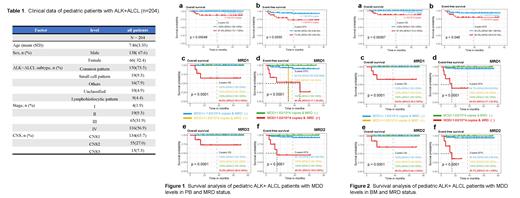# Keyan Yang and Jing Yang contribute equally to this article.
* Corresponding to both Qinlong Zheng (zhengql@gobroadhealthcare.com) and Yonghong Zhang (zhangyongh@gobroadhealthcare.com)
Backgrounds:
Anaplastic lymphoma kinase positive anaplastic large cell lymphoma (ALK+ALCL) is characterized by the occurrence of the ALK fusion and subsequently ALK fusion kinase protein expression. It has been reported that minimal disseminated disease (MDD) and minimal residual disease (MRD) detected by RQ-PCR are independent prognostic factors.
Purpose & Methods:
To explored the prognostic roles of MDD and MRD in Chinese pediatric patients with ALCL, we conduct a retrospective study in a cohort of 204 Chinese children and adolescent ALK+ALCL patients treated at multiple centers of the China Network of Childhood Lymphoma (CNCL). The median follow-up time was 39 months (95%CI: 34-44.7). MDD level as ALK fusion copy number was measured by quantitative RT-PCR at the initial diagnosis. Based on the Overall Survival (OS) data, cut-off values of 1.63 in peripheral blood (PB) and 1.43 in bone marrow (BM) were determined by using the maximally selected rank statistics, with the c-index values of 0.904 in PB and 0.895 in BM.
Results:
The prevalence of MDD in PB and/or BM of Chinese pediatric patients with ALK+ALCL was 24.8%, while the MDD level were significantly correlated between PB and BM (R=0.8, p<2.2e-16). In addition, the 3-year OS (PB, 87.8% vs. 100%; BM, 87.9% vs. 100%) and EFS (PB, 73.2% vs. 94.8%; BM, 80.0% vs. 93.2%) were revealed with significant difference, when analyzed by MDD level. The combined analyses of both MDD level (with the same cut-off value) and MRD results (positive vs. negative), either after 1 st course of treatment (MRD1) or 2 nd course of treatment (MRD2), indicated the further poor prognosis, both in 3-year OS (PB, MRD1, 64.8% vs. 100%, MRD2, 72.9% vs. 100%; BM, MRD1, 64.8% vs. 100%, MRD2, 68.8% vs. 100%) and EFS (PB, MRD1, 40.0% vs. 95.3%, MRD2, 45.0% vs. 95.1%; BM, MRD1, 40.0% vs. 94.7%, MRD2, 35.7% vs. 94.4%).
Conclusion:
Summary, in this work, MDD level detected by quantitative RT-PCR was revealed as a strong factor in prognostic evaluation of Chinese children and adolescent patients with ALK+ALCL, which showed its important role in clinical detection at initial diagnostic. In future, the further validation work could be carried out in different cohort of ALK+ALCL patients, even with larger enrolled population size and longer follow-up time.
Disclosures
No relevant conflicts of interest to declare.


This feature is available to Subscribers Only
Sign In or Create an Account Close Modal